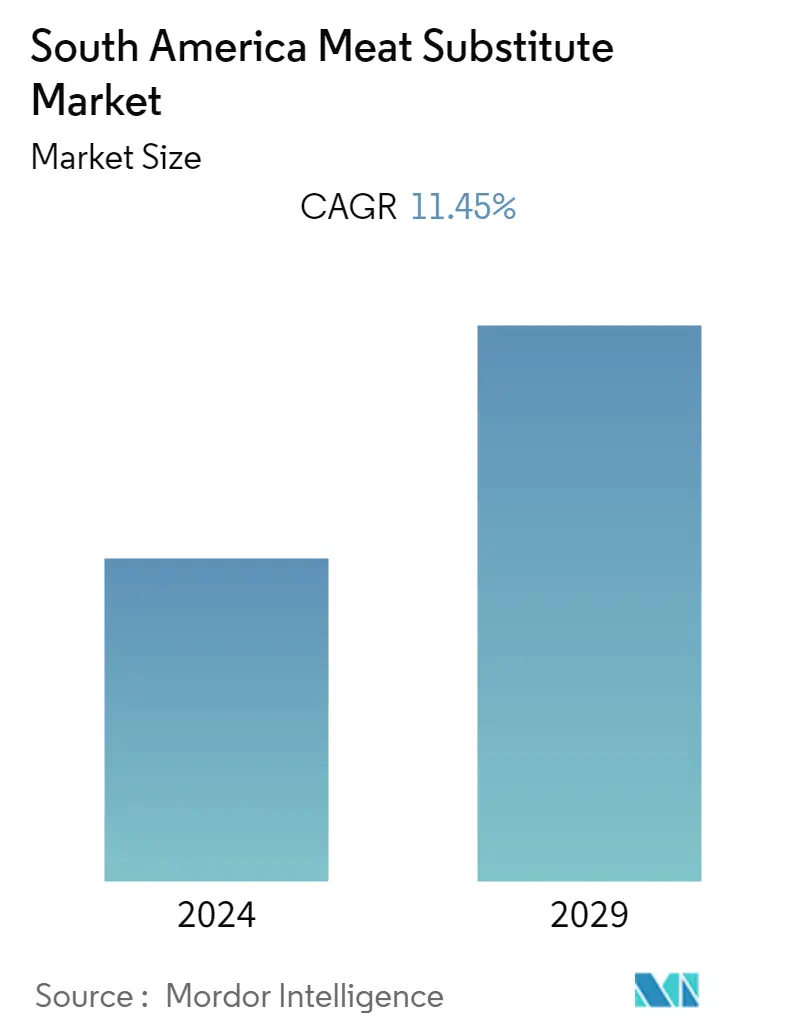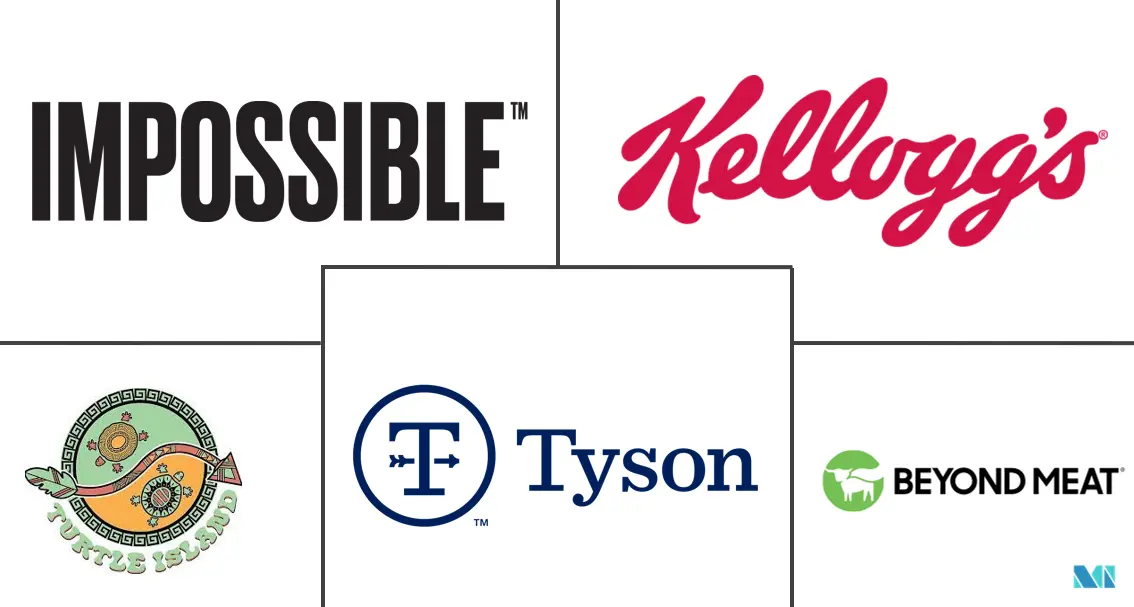Market Size of South America Meat Substitute Industry

| Study Period | 2019 - 2029 |
| Base Year For Estimation | 2023 |
| Forecast Data Period | 2024 - 2029 |
| Historical Data Period | 2019 - 2022 |
| CAGR | 11.45 % |
| Market Concentration | Low |
Major Players
*Disclaimer: Major Players sorted in no particular order |
South America Meat Substitute Market Analysis
The South American meat substitute market is projected to register a CAGR of 11.45% during the forecast period.
- Due to the rising recognition of the advantages of a vegetarian diet, the demand for plant-based meals expanded along with changing lifestyles. This, in turn, drives the growth in the meat substitute market. Although animal sources are rich in protein, the excessive consumption of animal-based products may result in chronic diseases, including obesity, cardiovascular disorder, and diabetes.
- Due to the above factors, meat consumption has stagnated across Latin America and is expected to decrease in the coming years. According to CONAB, Brazil's meat consumption dropped from 20.2 million metric tons the year before to under 20 million tons in 2022.
- Additionally, in recent years, the growing concern about animal abuse for meat production has greatly impacted the way consumers think about meat consumption. This factor further changes the consumer's choice of plant-based meat products to reduce animal slaughtering for meat and thereby increase the demand for meat analogs in the market.
- For instance, in 2021, a global survey by Green Queen on changing consumers' patterns towards vegan diets involving 8500 participants across 100 countries reported that nearly 90% of respondents cited animal welfare as a primary reason for the inclination toward a plant-based diet.
- However, plant-based meat has low cholesterol levels, saturated fats, and calories and is enriched with micronutrients such as calcium and zinc. Thus, the growing consumer consciousness regarding health is increasing the demand for plant-based meat products and further fueling market growth.
- Owing to the consumer demand for meat analogous, the manufacturers are focusing on producing innovative plant-based meat products to cater to the need. Further, the consumers perceive that replacing animal-based meat with meat substitutes can lower the risk of heart disease as plant-protein food can lower cholesterol levels.
South America Meat Substitute Industry Segmentation
Meat sourced from plants are called plant-based. Meat can be produced more effectively by excluding animals and using plant-based ingredients to manufacture meat substitutes.
The South American meat substitute market is segmented by type, distribution channel, source, and geography. Based on type, the market is segmented into textured vegetable protein, tofu, tempeh, seitan, quorn, and other types. Based on distribution channels supermarkets/hypermarkets, online retail, specialty stores, and other retail channels. Based on source, the market is segmented into soy-based, wheat-based, mycoprotein-based, and other sources. Based on geograhy, the market is segmented into Brazil, Argentina, and the Rest of South America.
For each segment, the market sizing and forecasts have been done based on value (in USD Million).
| Product Type | |
| Tofu | |
| Textured Vegetable Protein | |
| Tempeh | |
| Seitan | |
| Quorn | |
| Other Product Types |
| Source | |
| Soy-based | |
| Wheat-based | |
| Mycoprotein |
| Distribution Channel | |
| Supermarkets/Hypermarkets | |
| Online Retail | |
| Speciality Stores | |
| Other Retailers |
| Geography | |
| Brazil | |
| Argentina | |
| Rest of South America |
South America Meat Substitute Market Size Summary
The South American meat substitute market is experiencing significant growth, driven by increasing consumer awareness of the health and environmental benefits of plant-based diets. As lifestyles evolve, there is a growing recognition of the advantages of vegetarian diets, which has led to a surge in demand for meat substitutes. This shift is further fueled by concerns over the health risks associated with excessive consumption of animal-based products, such as obesity and cardiovascular diseases. Additionally, ethical considerations regarding animal welfare have prompted consumers to opt for plant-based alternatives, reducing the demand for traditional meat products. The market is characterized by a diverse range of innovative plant-based meat products, with manufacturers focusing on meeting the rising consumer demand for healthier and more sustainable food options.
Textured Vegetable Protein (TVP), particularly soy and wheat-based varieties, holds a significant share of the meat substitute market due to its desirable qualities, such as texture and binding ability, making it suitable for various meat products. The increasing demand for TVP has led to a rise in soybean and wheat production in Latin America, with Brazil being a major contributor. The market is competitive and fragmented, with numerous local and international players striving to meet consumer needs through product development and innovation. Key industry players, including Beyond Meat, Tyson Foods, and Impossible Foods, are leveraging strategies such as mergers and acquisitions to maintain their market dominance. Recent partnerships and funding initiatives, such as those by Verdali and Tomorrow Foods, highlight the ongoing efforts to expand product lines and penetrate new markets, further solidifying the growth trajectory of the meat substitute market in South America.
South America Meat Substitute Market Size - Table of Contents
-
1. MARKET DYNAMICS
-
1.1 Market Drivers
-
1.2 Market Restraints
-
1.3 Porter's Five Forces Analysis
-
1.3.1 Threat of New Entrants
-
1.3.2 Bargaining Power of Buyers/Consumers
-
1.3.3 Bargaining Power of Suppliers
-
1.3.4 Threat of Substitute Products
-
1.3.5 Intensity of Competitive Rivalry
-
-
-
2. MARKET SEGMENTATION
-
2.1 Product Type
-
2.1.1 Tofu
-
2.1.2 Textured Vegetable Protein
-
2.1.3 Tempeh
-
2.1.4 Seitan
-
2.1.5 Quorn
-
2.1.6 Other Product Types
-
-
2.2 Source
-
2.2.1 Soy-based
-
2.2.2 Wheat-based
-
2.2.3 Mycoprotein
-
-
2.3 Distribution Channel
-
2.3.1 Supermarkets/Hypermarkets
-
2.3.2 Online Retail
-
2.3.3 Speciality Stores
-
2.3.4 Other Retailers
-
-
2.4 Geography
-
2.4.1 Brazil
-
2.4.2 Argentina
-
2.4.3 Rest of South America
-
-
South America Meat Substitute Market Size FAQs
What is the current South America Meat Substitute Market size?
The South America Meat Substitute Market is projected to register a CAGR of 11.45% during the forecast period (2024-2029)
Who are the key players in South America Meat Substitute Market?
Kellogg's Company, Turtle Island Foods (Tofurky), Tyson Foods, Inc., Impossible Foods Inc. and Beyond Meat, Inc. are the major companies operating in the South America Meat Substitute Market.

